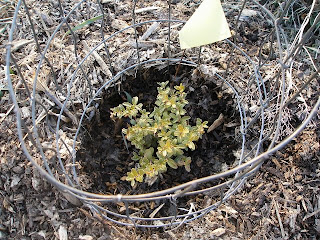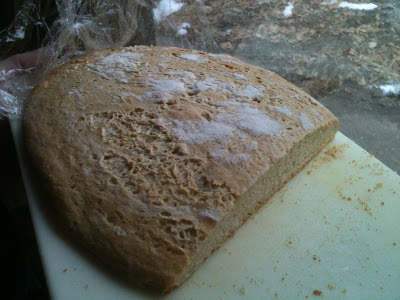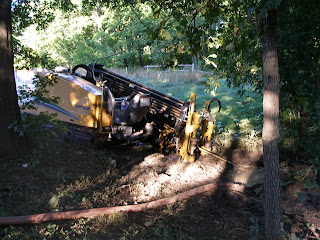Ligonberry AntiFreeze
On our last warm day, before our current blizzard, I walked the orchard.
The Snow Mulch is still piled beneath the Plums and Cherries.
Two plants are already green. The Ultra-Hardy Ligonberry noted below and the
Creeping Thyme is also making its way through the cold ground.
I have one potted Ligonberry in the house that is doing well and even grew some.
The Ligonberries are doing ,much better than the Blue Berries. The soil is not acid enough and adding amendments is not sustainable.
From Ligonberry.com:
The Lingonberry, or dry ground Cranberry, is a common wild fruit species found in our northern forests. It is closely related to the bog cranberry, which is the cranberry that is widely used in North America and Europe for holidays and special occasions. Traditionally, northern people around the world have made extensive use of the Lingonberry. People from Northern Europe, Canada, as well as Alaska consider this fruit to be an important diet staple. Historical references suggest that many European explorers, and Native people considered Lingonberries one of the most important edible wild fruits.
The Lingonberry has many common names: Norway calls it "Tyttebaer"; Sweden refers to it as "Lingon"; Finland calls it "Puolukka"; and in parts of Alaska and Canada it is known as the "Rock Cranberry" or "Mountain Cranberry". Some have compared the Lingonberry to the commercially grown Cranberry; but, the Lingonberry has a distinct, very intense flavor like no other berry.
Lingonberries can be used fresh or frozen, incorporated into sauces, syrups, jellies, fillings, as well as drinks. Lingonberries have a one of a kind taste, that puts them in a class by themselves, and will complement any meal.
http://www.sln.potsdam.ny.us/lingonberries.html
LINGONBERRIES
http://www.sln.potsdam.ny.us/ling600.GIF
The Lingonberry, Vaccinium vitis-idaea, is a low-growing (12 in. at maturity) circumpolar, evergreen groundcover closely related to partridgeberry. The berries ripen in August and are red, tart and smaller than cranberries but with a finer flavor. Lingonberries, like blueberries, thrive in acid soils, pH 3.5 to 5. Their fragile root systems spread through the superficial soil layers by runners which develop buds and new shoots. Plants are small and slow to establish. They require hand-weeding, mulching, attention to pH, and frequent watering during the first two seasons. Lingonberries are beautiful and delicate-looking ornamentals. They will produce more fruit in full sun, but the plants will grow in dappled shade. if you have mountain property with a pH low enough to grow wild blueberries, lingonberries should do well for you.
Pollination Lingonberries are self-fruitful. (Two varieties not required.)
Today we topped off the Heating Oil.

Too much used this past winter. Somethings gotta give here.
We can't going burning this stuff. Payback is now 5 years for a solar collector array.
Everytime the price of gas goes up the solar option pays back faster.
The Lingonberry, or dry ground Cranberry, is a common wild fruit species found in our northern forests. It is closely related to the bog cranberry, which is the cranberry that is widely used in North America and Europe for holidays and special occasions. Traditionally, northern people around the world have made extensive use of the Lingonberry. People from Northern Europe, Canada, as well as Alaska consider this fruit to be an important diet staple. Historical references suggest that many European explorers, and Native people considered Lingonberries one of the most important edible wild fruits.
The Lingonberry has many common names: Norway calls it "Tyttebaer"; Sweden refers to it as "Lingon"; Finland calls it "Puolukka"; and in parts of Alaska and Canada it is known as the "Rock Cranberry" or "Mountain Cranberry". Some have compared the Lingonberry to the commercially grown Cranberry; but, the Lingonberry has a distinct, very intense flavor like no other berry.
Lingonberries can be used fresh or frozen, incorporated into sauces, syrups, jellies, fillings, as well as drinks. Lingonberries have a one of a kind taste, that puts them in a class by themselves, and will complement any meal.
http://www.sln.potsdam.ny.us/lingonberries.html
LINGONBERRIES
http://www.sln.potsdam.ny.us/ling600.GIF
The Lingonberry, Vaccinium vitis-idaea, is a low-growing (12 in. at maturity) circumpolar, evergreen groundcover closely related to partridgeberry. The berries ripen in August and are red, tart and smaller than cranberries but with a finer flavor. Lingonberries, like blueberries, thrive in acid soils, pH 3.5 to 5. Their fragile root systems spread through the superficial soil layers by runners which develop buds and new shoots. Plants are small and slow to establish. They require hand-weeding, mulching, attention to pH, and frequent watering during the first two seasons. Lingonberries are beautiful and delicate-looking ornamentals. They will produce more fruit in full sun, but the plants will grow in dappled shade. if you have mountain property with a pH low enough to grow wild blueberries, lingonberries should do well for you.
Pollination Lingonberries are self-fruitful. (Two varieties not required.)
Today we topped off the Heating Oil.

Too much used this past winter. Somethings gotta give here.
We can't going burning this stuff. Payback is now 5 years for a solar collector array.
Everytime the price of gas goes up the solar option pays back faster.



Comments